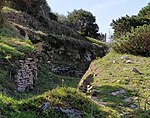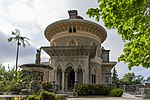Azenhas do Mar

Azenhas do Mar (Portuguese pronunciation: [ɐˈzeɲɐʒ ðu ˈmaɾ]) is a seaside town (residential neighborhood) in the municipality of Sintra, Portugal. It is part of Colares civil parish. Azenhas do Mar means Watermills of the Sea and the name derives from a once-powerful stream that moved the watermills as it made its way to the sea.It is located just 30 km (19 mi) away from Lisbon, near Cabo da Roca, Palácio da Pena (Pena Palace), and other attractions.The place is a Mediterranean-looking village with white houses tumbling down to the Atlantic. In the mid-20th century, wealthy families from Lisbon and Sintra decided that the location was perfect for summer homes, which can be seen outside the main cluster of houses that originally were a fishing community's homes.There are several popular beaches located near the Azenhas do Mar, namely Praia da Aguda, Praia do Magoito (mostly frequented by locals and surfers), and Praia das Maçãs.Near Praia das Maçãs there is a Prehistoric Monument, also known as the Tholos of Outeiro das Mós, consists of an artificial Neolithic cave and a Chalcolithic domed or beehive tomb.
Excerpt from the Wikipedia article Azenhas do Mar (License: CC BY-SA 3.0, Authors, Images).Azenhas do Mar
Caminho da Amoreira,
Geographical coordinates (GPS) Address Nearby Places Show on map
Geographical coordinates (GPS)
| Latitude | Longitude |
|---|---|
| N 38.840555555556 ° | E -9.46 ° |
Address
Caminho da Amoreira
Caminho da Amoreira
2705-105 (Colares)
Portugal
Open on Google Maps









